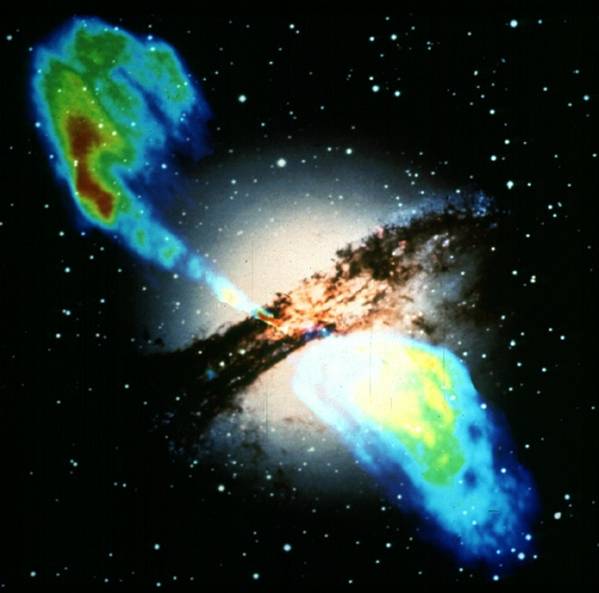
|
|

|
|
In normal galaxies because they are clusters of stars, gas, dust, and dark matter, their light is produced primarily by stars , that is, by hot dense balls of gas with typical luminosities on the order of a few 10s of billions times that of the Sun. The light from normal galaxies is said to be stellar in nature (thermal, roughly blackbody in character)

|
 solar spectrum plotted against wavelength |
 |
Above left is shown a rainbow, in the middle is shown a plot of the Solar spectrum where the intensity is binned in intervals of the wavelength of the radiation. This is the way in which stellar spectra are usually presented. To the right is how similar spectra would appear if the intensity is binned in intervals of the energy of the radiation (or the frequency of the radiation). This is how spectra are often times presented in Cosmology and Extragalactic astronomy.
The emission from active galactic nuclei (AGNs) is different in character, origin, and amount than the emission from normal galaxies. Such AGNs are not uncommon as nearly 40 % of the bright galaxies are active. Their luminosity is not produced by stars; their emission is nonstellar (nonthermal) in origin.

We return to the emission mechanism later.
We talk about three types of AGNs which lie at the bright end of their population. We consider Seyferts, Radio Galaxies, and QSOs.
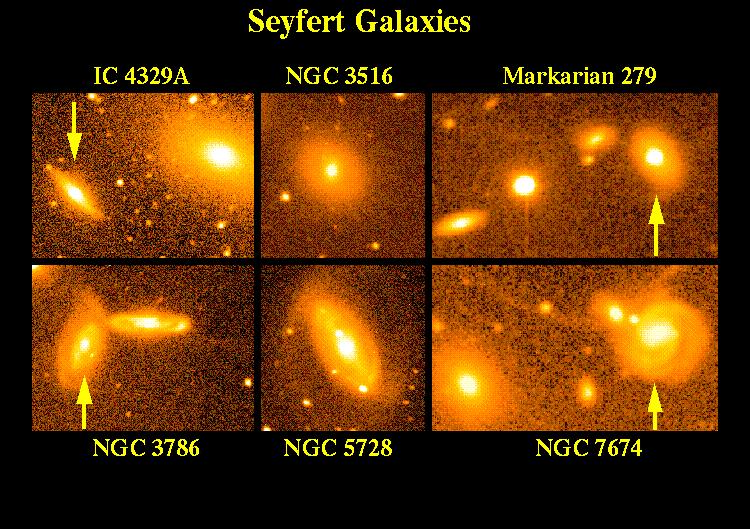 |
|
Two general classes, compact (core-halo galaxies) systems and extended (lobe radio galaxies) systems. And, despite their names, radio galaxies typically emit more energy outside of the radio band than in it.
 |
M87M87 is classified as a super-Giant Elliptical galaxy (cD) and is the largest and most luminous galaxy and is located near the center of the Virgo cluster of galaxies (it has likely grown through galactic cannibalism). M87 is large, within 100,000 light years of its center is contained 2.4x1012Solar masses, more than double that of the Milky Way galaxy. The mass of M87 may be more than 100 times that of the Milky Way! At the core of M87 is a black hole of mass 3.2x109 Solar masses which is thought to power its extreme brightness; the core only needs to eat a Solar mass of material every 10 years or so. Interestingly, the black hole sits around 80 light years off the center of M87 with a one-sided jet emanating from the core. |
Compact radio galaxies. In compact (core-halo) galaxies, the luminosity is dominated by the emission from a bright nuclear region (of size a few light years) with weaker emission coming from a larger extended halo (contained within the optical image of the galaxy). As typical of AGNs, there are jets emanating from the nuclear region.
 | Cygnus ACygnus A was one of the first radio galaxies discovered (Reber 1939) and is one of the strongest radio sources in the sky. Cygnus A is a fine example of a double-lobe radio galaxy with two oppositely directed jets emanating from its central region. The jets are huge, with ends separated by over half a million light years. At the ends of the jets are two lobes with hot spots of intense radiation at their edges. The hot spots likely form where the jets run into the intergalactic medium. |
 | Cen ACen A is either an elliptical galaxy or a lenticular galaxy (with a deep, dark dust lane easily seen in photographs) with an active nucleus. The strange appearance may be the result of a galaxy merger (having eaten a large spiral within the last half-billion years). A fast jet is seen emanating from the core of Cen A which is believed to contain a supermassive black hole, perhaps on the order of a billion times the mass of the Sun. If the fast jets move close to the speed of light, then they are consistent with being emitted several hundrec million years ago, around the time of the hypothesized galaxy collision. |
 | 3C219
Another strong, double-lobed radio galaxy. |
Hubble Space Telescope (HST) pictures of radio galaxies.
In 1963 Maarten Schmidt first identified Quasars (quasi-stellar radio source). Most Quasars are radio-quiet however (in that they emit much more optical radiation than radio radiation). Quasars are extremely bright in the optical and higher energies and appear star-like on photographic plates (===> their more appropriate name, Quasi-Stellar Object QSO). I will tend to use QSO in this class.
The nature of QSOs was initially mysterious because their spectra defied interpretation. The first QSO, 3C48 was discovered in 1960. The famous QSO 3C273 was discovered in 1962. Maarten Schmidt was the first to recognize and solve the problem,

Most QSOs cannot be associated with normal galaxies, because of their great brightnesses and distances. However, several QSOs are located within normal host galaxies prompting one to believe that all QSOs are housed in normal galaxies. The great distances of most QSOs suggests that they formed early in the evolution of the Universe.
Object Visible Radio Infrared X-ray Normal Galaxy 2 0.000001 0.1 0.0001 Radio 2-10 0.01-100 0.1 <0.01 Seyfert of N-type 2 0.001-100 1,000 0.01-10 QSOs (3C273) 1,000 1-1,000 10,000 100-??
<-Radio Galaxies->
<---------Seyferts--------->
<----------------------QSOs----------------------->
Relative Distance From Milky Way
The above shows that although AGNs have unusual (and odd)
properties, they appear to be one class of object which ranges from not
so outlandish properties to amazing properties.
Comment--Because of their large luminosities and small sizes, it was initially hoped (by some researchers) that QSOs were not at the distances suggested by their redshifts. If they were actually closer, then their estimated luminosities would decrease and many problems would be eased. However, based on several arguments (e.g., association with galaxies in some cases, gravitational lensing, and reasonable explanations for super-luminal motion) the issue is probably settled.
Comment--There are more AGNs at large distances than in our local neighborhood. Recall that due to the finite speed of light (300,000 km per second), the light from distant objects takes a long time to reach us. This means that the light we receive today from a distant object, left that object many years in the past. That is, we look back in time as we peer to large distances in the Universe.
===> AGNs were more common when the Universe was young than today.
To summarize the lecture up until now, the basic features of AGNs with which we must contend are:
Much of the radiation from AGNs is thought to be due to a process known as synchrotron emission. Synchrontron emission is produced when an energetic electron moves (spirals) through a region which contains a magnetic field.

The principal issues are the high brightnesses and small sizes of AGN. We therefore need an exceedingly efficient way to produce energy. A natural energy engine is a black hole.
A black hole is an object whose escape speed is equal to c, the speed of light ===> light cannot escape from the object and the object appears black!
Small Size
(The radius of a nonrotating black hole is named the Schwarzschild radius in honor of the man who first worked out the theory.) For comparison, a normal star like the Sun has a diameter of 1,400,000 kilometers which is over 200,000 times larger! Even a black hole which is as massive as 109 M(Sun) has a diameter of only 6x109 kilometers ~ 40 AUs, the size of our Solar System! Even very massive black holes are small enough to hide in AGNs.
Energy Production
A similar engine could work in AGNs. A black hole energy engine is more efficient than nuclear fusion in the following sense.
Occassionally, a member (below left shows S2 in the core of the Milky Way galaxy) of the beehive of stars at the cores of galaxies passes too close to the central black hole. Tidal forces can then tear these unfortunate stars apart. The debris then slowly spirals into the black hole. As we noted earlier, the black hole must eat 10 or so stars per year. The material gains and releases energy as it spirals onto the black hole (below right). The tidal force weakens as the black hole eats stars (increases in mass). This occurs because the diameter of the black hole increases as it eats stars. When the mass of the black hole reaches several billion time the Solar mass, the tidal force is not strong enough to rip the passing stars apart. As a result, unless the star actually runs into the black hole (which is not likely), the star will simply pass the black hole by. The weakening of the tidal force stops the flow of material onto the black hole and the AGN shuts off.
 |

|
A supermassive black hole must eat roughly 1 star like the Sun every 10 years to power low energy Seyferts to hundreds to a thousand or so stars like the Sun every year to power the brightest QSOs.
For QSOs, the brightest ones will not last for more than several million years, because they run out of fuel or they become too massive which, paradoxically, makes them unable to tidally disrupt passing stars..
Comparison to Reality
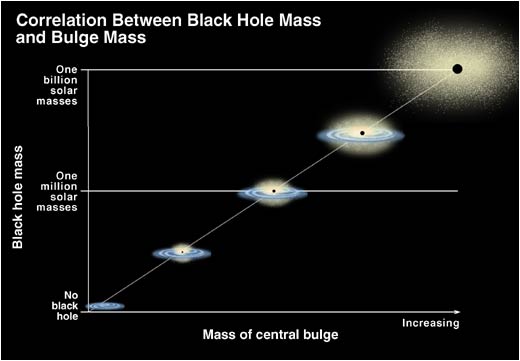 | In the cores of AGNs, a supermassive 108 to 109 M(Sun) may live where the stellar density is very high. It has been discovered that the mass of the black hole correlates with the bulge mass of the host galaxy; roughly 15 % of the bulge mass is contained in the black hole. What does this mean?
|
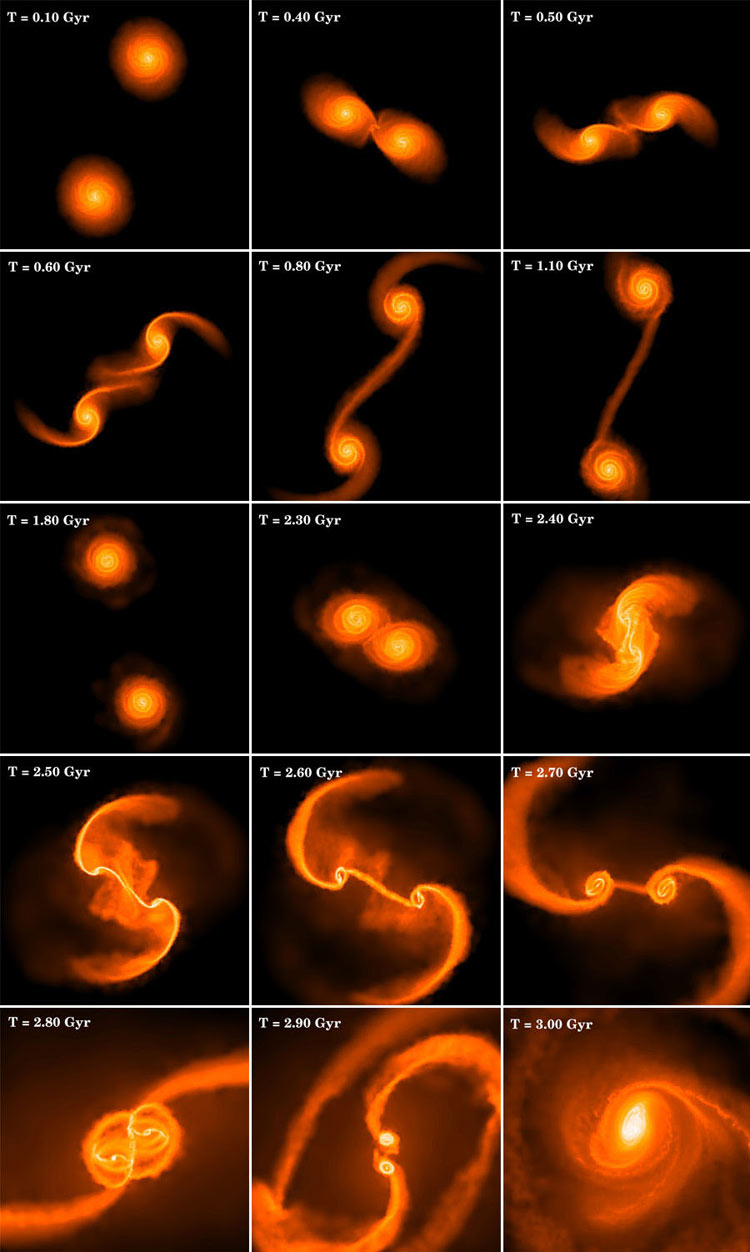 | As a possiblity, note that when galaxies form, around 15 % of the bulge mass forms a supermassive black hole. Consequently, when such galaxies merge, it is conceivable that their black holes may coalesce forming a larger supermassive black hole.Using supercomputers, simulations of the merger of two galaxies, each of which contains a supermassive black holes have been performed (see the panel to the left). The galaxies initially approach, tidally pulling streams of gas from each other, not coming close enough to merge, but capturing each other. As they return to interact, they interact more strongly eventually settling into a system composed of a close pair of supermassive black holes surrounded by a several hundred million to billion Solar mass gas disk. After the formation of the double black hole, it is expected that the black holes will radiate gravitational radiation and slowly spiral together. The entire process shown takes around 3 billion years. 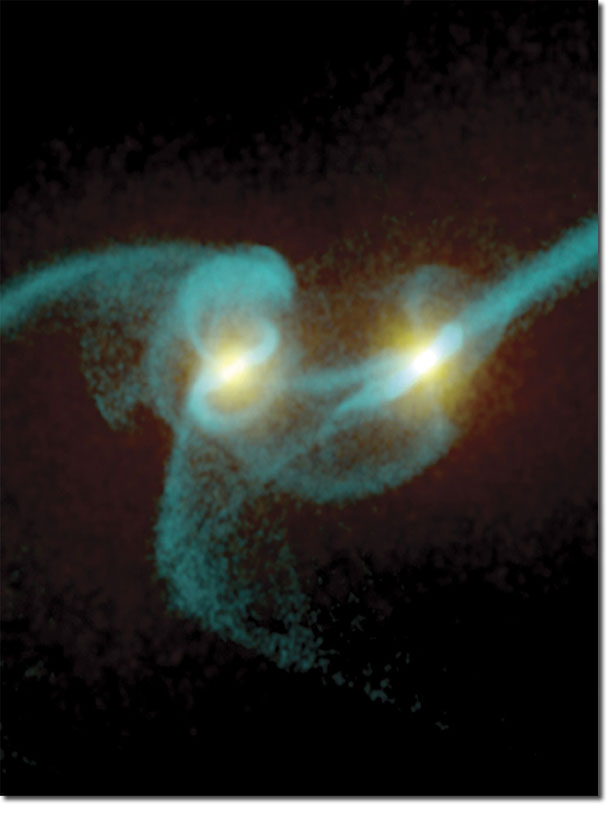
NGC 6240 contains two supermassive black holes separated by 3,000 light years. The black holes will merge in the next few hundred million years. |
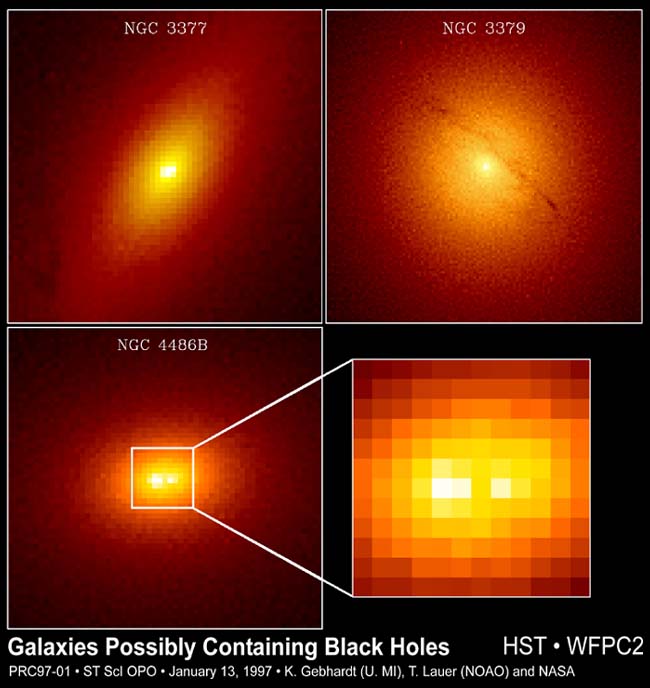 |
|
| 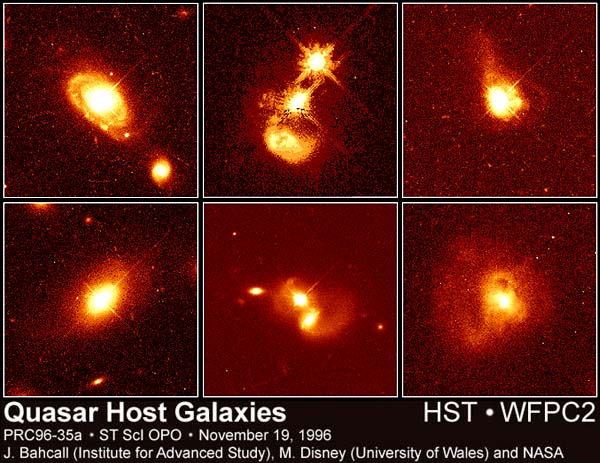 |